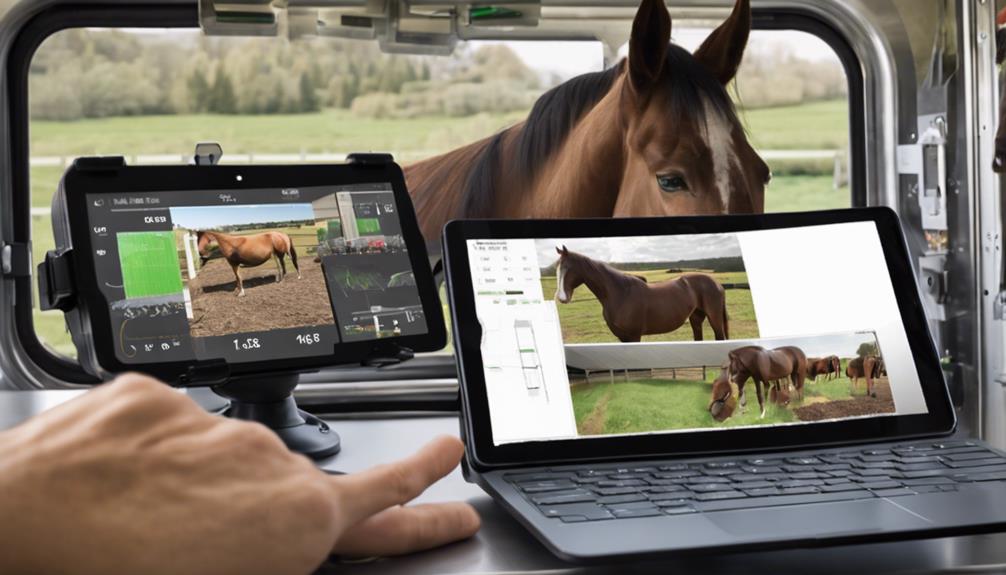Essential Horse Transportation Strategies for Farms
When it comes to transporting horses on your farm, think of it like orchestrating a delicate ballet – every move must be well-coordinated and precise.
From planning the routes to managing travel stress, each step plays a crucial role in ensuring the safety and well-being of your equine companions.
By mastering essential horse transportation strategies, you can not only streamline your operations but also provide a comfortable journey for your horses.
Let's explore the key elements that will help you navigate this intricate process smoothly.
Planning Horse Routes
When planning horse routes, consider the distance, terrain, and accessibility for the smooth transportation of your horses. Route optimization is key to ensuring that your horses have a safe and comfortable journey. By carefully planning the route, taking into account factors such as road conditions and traffic patterns, you can minimize travel time and reduce stress on your horses. It's important to map out the most efficient path to your destination, considering any potential obstacles or challenges along the way.
Travel schedules play a crucial role in planning horse routes. Make sure to schedule your trips at times when traffic is light to avoid delays and keep your horses calm during transit. Additionally, plan for rest stops to allow your horses to stretch their legs and take a break from travel. By sticking to a well-thought-out travel schedule, you can ensure that your horses arrive at their destination feeling refreshed and ready to go.
Choosing the Right Transport Vehicles
To ensure the safe and comfortable transportation of your horses, selecting the appropriate transport vehicles is crucial. When choosing the right transport vehicles for your horses, two key factors to consider are vehicle maintenance and driver training.
Proper vehicle maintenance is essential to ensure the safety of your horses during transportation. Regular maintenance checks on the transport vehicle, including the tires, brakes, and overall mechanical condition, are necessary to prevent breakdowns or malfunctions that could put your horses at risk. Make sure to schedule routine maintenance and inspections to address any potential issues before they escalate.
In addition to vehicle maintenance, providing adequate driver training is vital for the safety of your horses. Drivers should be well-versed in handling the specific transport vehicle and knowledgeable about best practices for loading and unloading horses. Proper training can help prevent accidents and ensure that your horses are transported in a stress-free environment.
Ensuring Horse Safety Measures
Properly implementing safety measures is essential to safeguard your horses during transportation. When preparing for a journey, ensure you have a well-equipped emergency response plan in place. This includes having essential items such as an equine first aid kit, contact information for a veterinarian, and knowledge of the nearest equine emergency services along your route. Regular health monitoring before, during, and after transportation is crucial. Keep a close eye on your horses' behavior, hydration levels, and overall well-being to address any issues promptly.
Before loading your horses, check that the trailer or vehicle is in optimal condition, with secure partitions, ventilation, and appropriate padding to prevent injuries. During transportation, make frequent stops to assess your horses' condition and offer them water and hay. Be prepared to handle any emergencies that may arise, such as sudden illnesses or injuries during transit. Familiarize yourself with basic first aid procedures and know how to contact emergency services if needed.
Loading and Unloading Procedures
Ensure your horses are calm and cooperative during loading and unloading procedures for safe transportation. Proper handling is crucial to minimize stress and ensure a smooth process. Start by desensitizing your horses to the trailer – allow them to explore it freely and reward them for positive interactions. Use a consistent approach and avoid rushing the loading process.
When loading your horses, lead them confidently and calmly. Ensure the ramp or step-up is secure and stable for their safety. Position yourself at their shoulder, guiding them gently but firmly. Avoid sudden movements or loud noises that could startle them. Once inside, secure them properly with a well-fitted halter and lead rope.
During unloading, maintain a similar level of calmness and control. Always unload them slowly and carefully, avoiding any abrupt actions. Open the trailer door and give them time to assess the situation before asking them to exit. Use a lead rope to guide them out, ensuring they step down safely.
Managing Travel Stress for Horses
Implement strategies to help horses cope with travel stress effectively. Stress management is crucial when transporting horses. To ensure their travel comfort, start by familiarizing them with the trailer. Allow the horses to explore the trailer before the journey, making it a less intimidating space. This familiarity can significantly reduce their stress levels during transit.
Another essential aspect of stress management during travel is ensuring proper ventilation in the trailer. Good air circulation helps maintain a comfortable environment for the horses and reduces the risk of respiratory issues due to poor ventilation. Additionally, consider using bedding to provide a cushioned and stable surface for the horses to stand on during the journey. This can help minimize the impact of movement and make the ride more comfortable for them.
Moreover, maintaining a consistent feeding schedule before and during travel can help alleviate stress for the horses. Familiar food and feeding routines provide a sense of normalcy and comfort, helping them feel more at ease during the journey. Hydration is also crucial, so make sure to offer water frequently to prevent dehydration.
Securing Necessary Permits and Documents
To transport horses legally and safely, you must acquire the necessary permits and documents. Ensuring legal compliance and meeting paperwork requirements is crucial for a smooth transportation process. Here are five essential points to consider:
- Permit Applications: Begin by researching the specific permit applications required for transporting horses in your region. Different areas may have varying regulations, so it's important to be thorough in this step.
- Documentation: Prepare all necessary documentation, such as health certificates, ownership papers, and travel permits. Having these ready beforehand will help streamline the process.
- Legal Compliance: Familiarize yourself with the legal requirements for transporting horses, including weight restrictions, rest stop mandates, and any special considerations for horse trailers.
- Paperwork Requirements: Double-check all paperwork requirements, ensuring that everything is up to date and accurate. Missing or incorrect paperwork can lead to delays or even fines.
- Professional Guidance: If you're unsure about any aspect of permit applications or documentation, seek guidance from professionals or local authorities. It's better to be safe than sorry when it comes to legal compliance.
Monitoring Horse Health During Transit

Keep a vigilant eye on your horses' well-being throughout the journey to ensure they remain healthy and comfortable during transit. Conduct regular health checks to monitor their condition, paying close attention to signs of distress or discomfort. Make sure your horses have access to fresh water to maintain proper hydration levels, especially on long trips. Dehydration can lead to serious health issues, so it's crucial to encourage drinking and offer water frequently.
Watch out for stress indicators in your horses' behavior, such as excessive sweating, restlessness, or unusual vocalizations. These signs can indicate that your horses are feeling overwhelmed or anxious during transit. Try to create a calm and soothing environment within the trailer by minimizing noise and sudden movements. Familiarize your horses with the trailer before the journey to reduce their stress levels and help them feel more at ease.
If you notice any concerning changes in your horses' health or behavior during transit, be prepared to take immediate action. Have a plan in place for emergencies and know who to contact for veterinary assistance if needed. By staying attentive to your horses' well-being and addressing any issues promptly, you can ensure a safe and comfortable journey for your beloved animals.
Developing Emergency Contingency Plans
Ensure the safety of your horses during transit by establishing detailed emergency contingency plans to address any unforeseen situations that may arise. When transporting your beloved equines, having a well-thought-out plan in place can make all the difference in ensuring their welfare. Here are some key points to consider when developing your emergency contingency plans:
- Communication Protocols: Set up clear communication channels with all involved parties, including drivers, staff, and emergency services, to ensure swift and effective coordination in case of emergencies.
- Shelter Options: Identify potential shelter locations along your route or at your destination where you can safely house your horses in case of extreme weather conditions or unexpected delays.
- Emergency Contact List: Compile a list of emergency contacts, including veterinarians, farriers, and local authorities, and keep it readily accessible during transit.
- Medical Supplies: Stock your horse trailer with essential medical supplies, such as first aid kits and medications, to address minor health issues or injuries promptly.
- Alternative Transport Plans: Have backup transport arrangements in place in case your primary vehicle breaks down or faces unexpected mechanical issues.
Frequently Asked Questions
How Can Farms Ensure the Comfort and Well-Being of Horses During Long-Distance Transportation?
To ensure your horses' comfort during long-distance transportation, implement comfort measures like soft bedding and proper ventilation. Use monitoring techniques such as checking on them regularly and offering water. Incorporate exercise routines by scheduling rest stops for stretching.
Follow safety precautions like securing the trailer properly and avoiding sudden stops. By prioritizing these aspects, you can help your horses stay relaxed and healthy throughout the journey.
What Factors Should Be Considered When Selecting Rest Stops for Horses During Transit?
When selecting rest stops for your horses during transit, prioritize their comfort and safety. Choose locations that provide ample space for them to stretch, access to fresh water, and shelter from extreme weather conditions.
Ensure the area is secure and free from hazards that could harm your horses. By carefully planning rest stops, you can promote travel safety and well-being for your equine companions during long journeys.
Are There Specific Feeding and Hydration Guidelines That Should Be Followed When Transporting Horses?
When transporting horses, it's crucial to follow specific feeding and hydration guidelines. Establish a feeding schedule that matches your horse's routine to prevent digestive issues.
Offer water frequently to meet their hydration needs. Plan travel breaks for rest and to rehydrate.
Comfort measures like providing ample bedding and good ventilation can help keep your horse calm and healthy during transport. Prioritize their well-being to ensure a smooth journey.
How Can Farms Prepare Horses for Transportation to Minimize Stress and Anxiety?
To prepare horses for transportation and reduce stress, consider training techniques and behavioral modifications. Introduce gradual exposure to trailers and practice loading and unloading.
Use positive reinforcement to create a calm association with transportation. Implement desensitization exercises to familiarize horses with potential stress triggers.
Ensure adequate rest and hydration before travel. By incorporating these strategies, you can help your horses feel more comfortable and secure during transportation.
What Are the Best Practices for Handling Emergencies or Unforeseen Circumstances During Horse Transportation?
In case of emergencies during horse transportation, you must have solid emergency protocols in place. Safety measures like regular checks on the horses' well-being, ensuring proper ventilation, and having a first aid kit handy are essential.
Stay calm, assess the situation, and prioritize the safety of the horses. Quick thinking and preparedness can make a huge difference in handling unforeseen circumstances effectively.
Conclusion
Overall, to ensure successful horse transportation for your farm, it's crucial to:
- Plan routes
- Choose suitable vehicles
- Prioritize safety measures
- Handle loading and unloading carefully
- Reduce travel stress
- Obtain necessary permits
- Monitor horse health
- Have emergency plans in place
By following these essential strategies, you can make sure that your horses arrive safely and comfortably at their destination every time.
